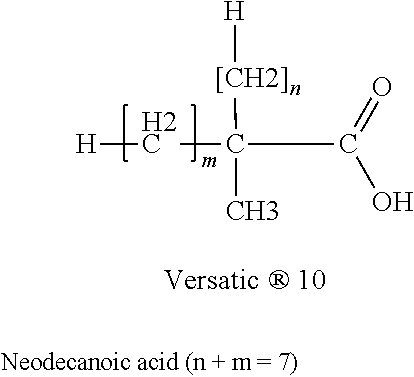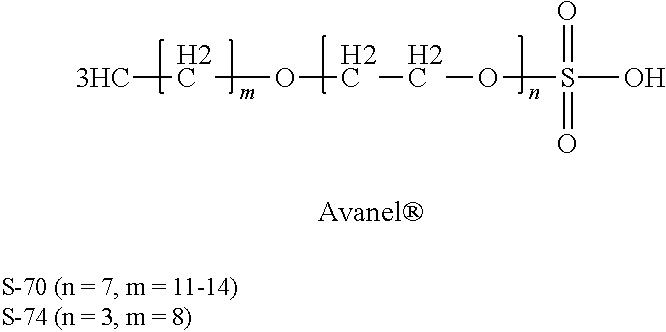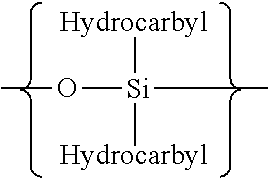Reducing the telogenic behavior of hydrocarbon-containing surfactants in aqueous dispersion fluoromonomer polymerization
a hydrocarbon-containing surfactant and fluoromonomer technology, applied in the direction of organic-compounds/hydrides/coordination complexes catalysts, physical/chemical process catalysts, coatings, etc., can solve the problems of telogenic behavior, achieve the effect of improving the usefulness of the surfactant, and improving the telogenic behavior
- Summary
- Abstract
- Description
- Claims
- Application Information
AI Technical Summary
Benefits of technology
Problems solved by technology
Method used
Image
Examples
example 1
[0167]This Example compares the polymerization process carried out with and without the presence of metal ion as passivation adjuvant, Fe+2 provided by iron(II) sulfate, FeSO4.7H2O, together with hydrocarbon surfactant.
[0168]
TABLE 1SurfactantMetal ionPumpedPumpedppmppmwt %BatchExp.oncation oncation onTime#mlwaterSaltwatersurfactantmin16371396None00165.0compar-ison2180424FeSO4—7H2O2.60.603251.2DispersionSTYExp.%Dv (50)Coag.gm / #Solidsnm%(L-hr)1-17.601441.1443.49comparison217.941501.12132.80
The total amount of make-up TFE added to the reactor in Experiments 1 and 2 is 1250 g in each experiment. The surfactant in these Experiments is sodium dodecyl sulfate (SDS) as described above. The surfactant is added to the aqueous medium in the reactor as an aqueous solution also containing the metal ions in the salt mentioned in Table 1. The stock solution containing the SDS and salt (Experiment 2) contains 1.439 g of the SDS and 0.0432 g of the salt / 100 g of water. The stock solution for Experim...
example 2
[0172]The Example compares polymerization results using SDS as the stabilizing surfactant and different amounts of metal cation as passivation adjuvant added with the SDS as reported in Table 2. The metal cation is Fe+2 provided by iron(II) sulfate, FeSO4.7H2O.
[0173]
TABLE 2Surfactant Sol'nSurfactantPumpedSol'nSDSppmwt %ConcentrationppmcationcationBatchExp.SDSSaltonononTime#gm / Lgm / LwaterwaterSDSmin314.390.2164471.30.301553.4414.390.4324052.40.602650.0514.390.6483713.40.904646.4DispersionSTYExp.%Dv (50)Coag.gm / #Solidsnm%(L-hr)316.261380.74111.46416.351220.33120.50516.631310.68130.51
The “Surfactant Sol'n Concentration” is the SDS and FeSO4.7H2O concentrations of the solution feed to the reactor. The “Salt gm / L” is the concentration of the salt, i.e. its total weight that includes the weight of the metal cation. This meaning is applicable to the same column heading in Tables that follow. The total amount of TFE makeup TFE is 1000 g. The polymerization of Experiment 4 produces the best r...
example 3
[0174]This Example carries out the polymerizations of Example 1 but to the use of a greater amounts of makeup TFE to produce higher %s solids. Experiments 6 and 7 employ 2200 g makeup TFE and Experiment 8 employs 3100 g makeup TFE. As in Example 1, the stabilizing surfactant is SDS and the metal cation is either Fe+2 provided as FeSO4.7H2O or Cu+2 provided by copper(II) sulfate, CuSO4.5H2O. The results are reported in Table 3.
[0175]
TABLE 3SurfactantSurfactant Solution PumpedSol'n Con-SDSwt %centrationppmppmcationExp.SDSSaltongmcat. onon#gm / Lgm / LwaterSALTSALTwaterSDS614.40.432627FeSO4•7H2O0.11663.80.6032714.60.388659CuSO4•5H2O0.10864.50.6751814.40.432932FeSO4•7H2O0.17735.60.6026TFEBatchDispersionSTYExp.FedTime%Dv (50)Coag.gm / #gmminSolidsnm%(L-hr)6220072.927.481831.66162.87220076.426.991610.17150.483100111.734.281951.22148.0
All of these polymerizations produce high % solids, accompanied by small particle size relative to this high % solids, together with relatively low % coagulum and ...
PUM
| Property | Measurement | Unit |
|---|---|---|
| temperature | aaaaa | aaaaa |
| temperature | aaaaa | aaaaa |
| temperatures | aaaaa | aaaaa |
Abstract
Description
Claims
Application Information
 Login to View More
Login to View More - R&D
- Intellectual Property
- Life Sciences
- Materials
- Tech Scout
- Unparalleled Data Quality
- Higher Quality Content
- 60% Fewer Hallucinations
Browse by: Latest US Patents, China's latest patents, Technical Efficacy Thesaurus, Application Domain, Technology Topic, Popular Technical Reports.
© 2025 PatSnap. All rights reserved.Legal|Privacy policy|Modern Slavery Act Transparency Statement|Sitemap|About US| Contact US: help@patsnap.com



